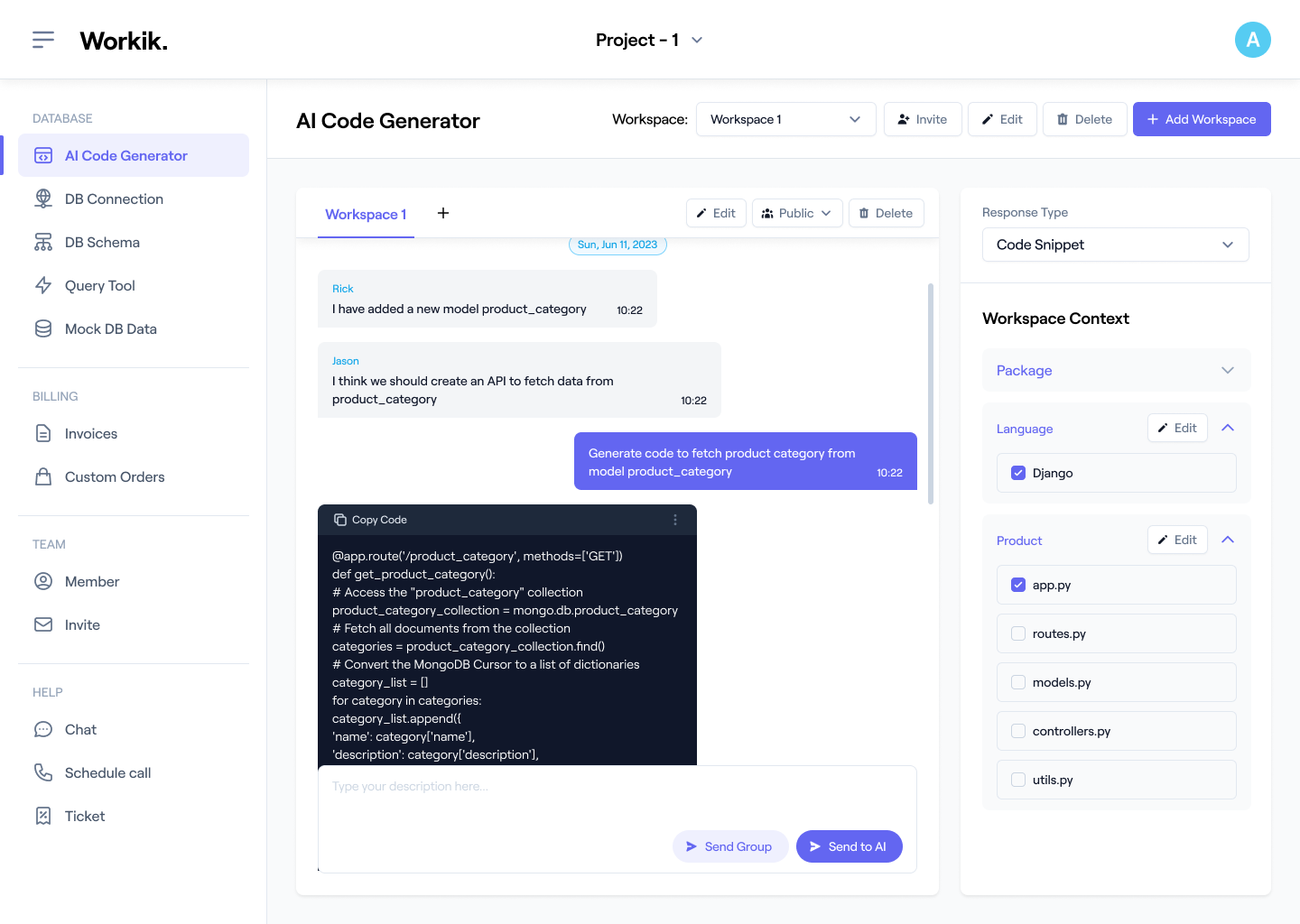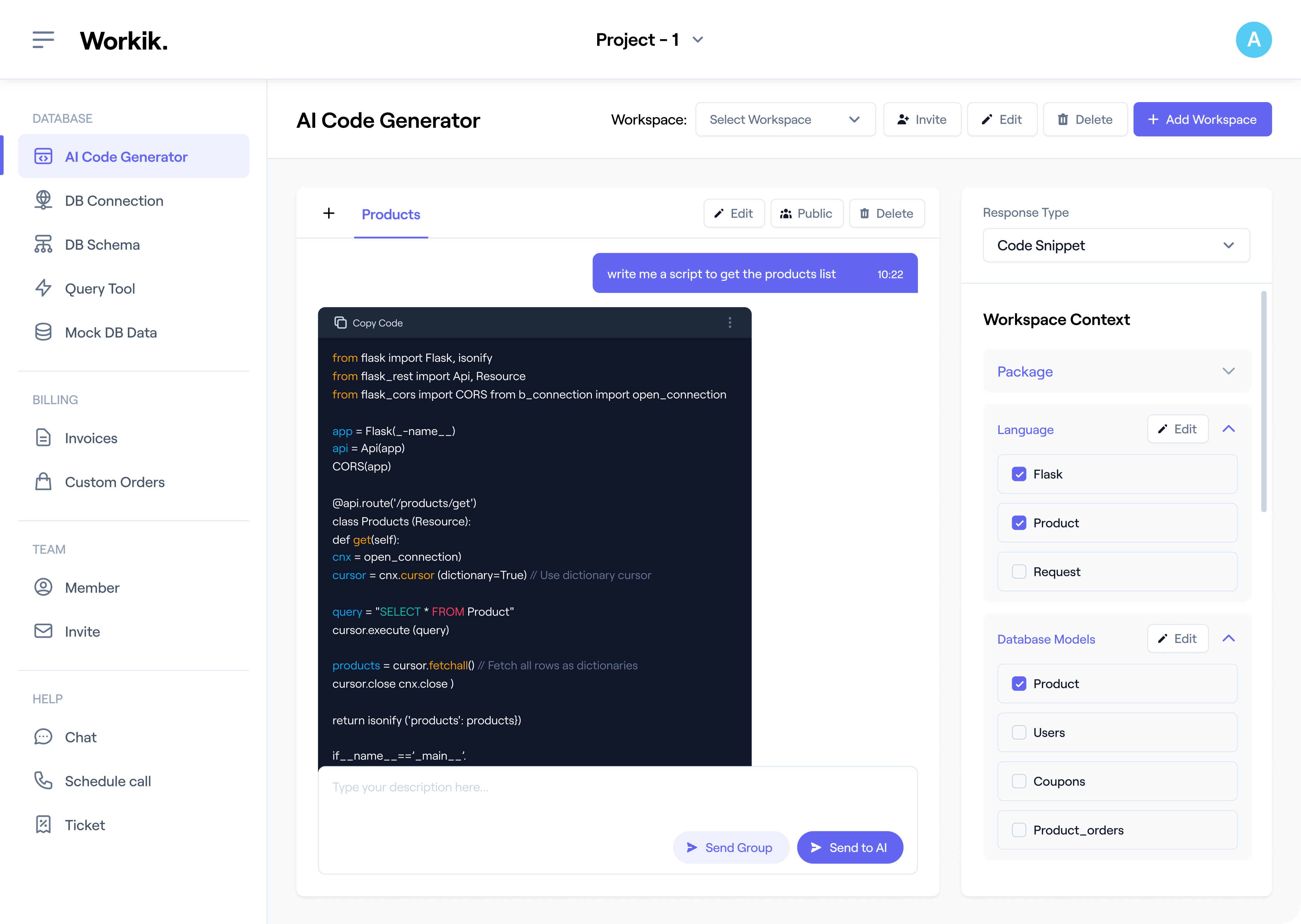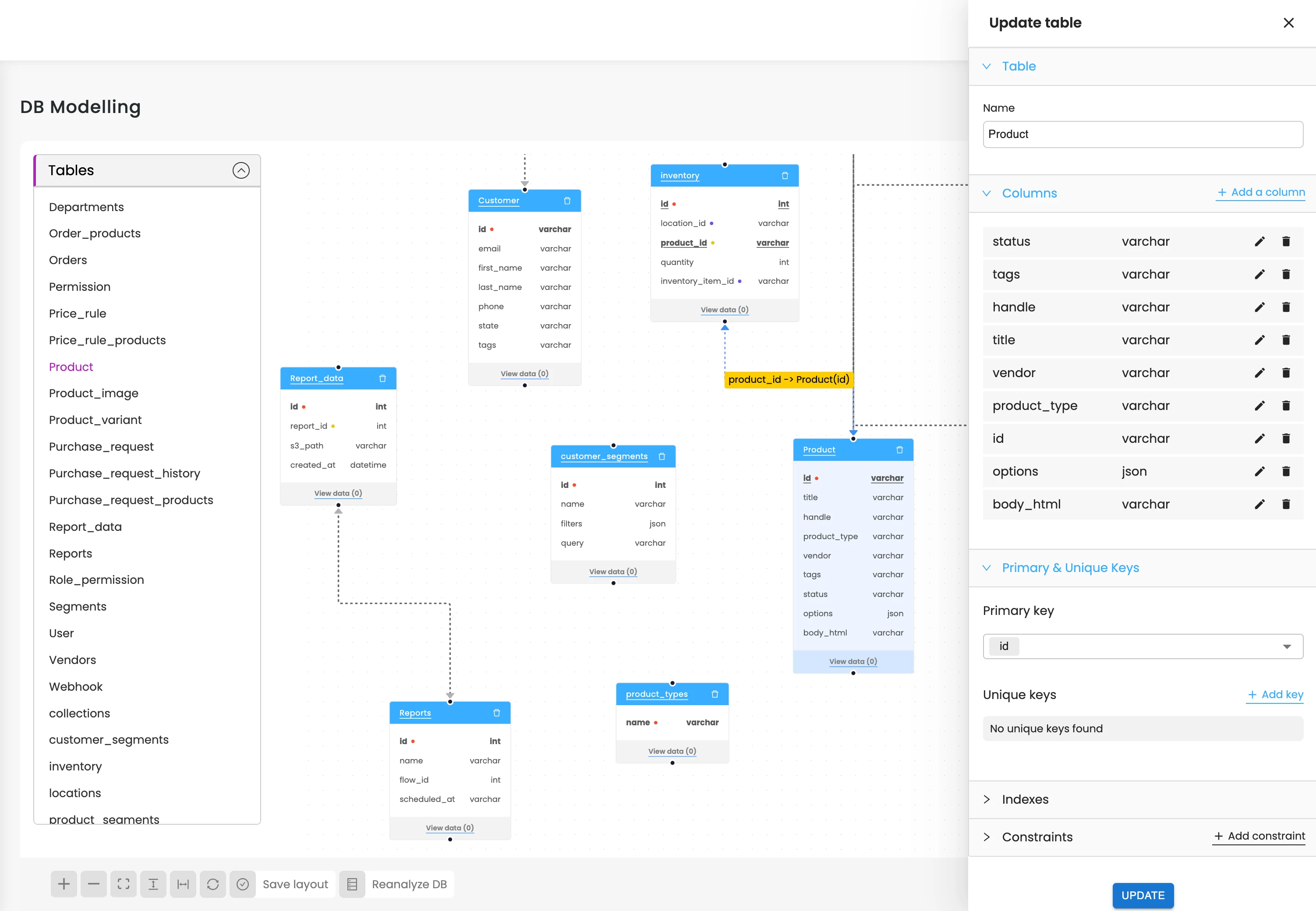
Join our community to see how developers are using Workik AI everyday.
Features

Craft Legacy Scripts
AI generates migration scripts for PostgreSQL/MySQL. SQLAlchemy ensures smooth schema translation.

Boost Migration Performance
AI suggests indexing and partitioning based on database size. Uses pg_stat_statements for tuning.

Generate Test Cases
AI can create test cases with pytest/dbtest to validate schema changes across SQL/NoSQL in staging.

Transform Complex Data
Leverage AI to streamline JSON-to-relational conversions, supporting Apache Beam/Talend for accurate migrations.
How it works
Easily sign up on Workik using Google or manually in seconds, and get started with your database migration project.
Sync your database schema from platforms like GitHub or Bitbucket. Specify database types, frameworks, and project needs for precise, AI-driven migration script generation.
Use AI to generate migration scripts, optimize schema, and handle SQL-to-NoSQL conversions. It also helps with testing, debugging, and validation.
Invite team members to Workik for real-time collaboration. Use AI to refine migration scripts, test for errors, and ensure smooth database transitions.


Expand
.png)
.png)
Expand


Expand


Expand


Expand


Expand


Expand


TESTIMONIALS
Real Stories, Real Results with Workik
Migrating from MySQL to PostgreSQL was a breeze with Workik’s AI. It generated scripts and handled schema validation, saving us days!

Alex Turner
Senior Database Engineer
As a junior dev, I used to struggle with migrations, but Workik’s AI made script generation and testing incredibly easy.

Emily Rojas
Junior Software Developer
The collaborative features and AI-driven optimizations in Workik completely transformed how my team handles DB migrations.

Michael Zhang
Lead DevOps Engineer
What are the popular use cases of Workik's AI for DB migration script generation?


Some popular use cases of Workik's AI-powered DB migration script generator include but are not limited to:
* Generate migration scripts for SQL and NoSQL databases like PostgreSQL, MySQL, and MongoDB.
* Optimize schema changes, indexing, and partitioning for large-scale database migrations.
* Convert database schemas between platforms (e.g., converting MySQL schemas to PostgreSQL).
* Manage complex data transformations, such as JSON-to-relational conversions, during migrations.
* Automate testing, debugging, and validation of migration scripts in staging environments.
What kind of context can I add in Workik AI related to DB migration script generation?


Setting context in Workik is optional but enhances AI-generated DB migration scripts. Here are the types of context you can add for DB migration script generation:
* Database types (e.g., MySQL, PostgreSQL, MongoDB for migration scripts).
* Database schemas (sync schemas from GitHub, GitLab, or Bitbucket).
* Data transformation requirements (e.g., JSON-to-relational, schema restructuring).
* Indexing and performance optimization configurations (to enhance migration efficiency).
* Testing frameworks (e.g., pytest, dbtest for validation of migration scripts).
How does Workik AI handle schema versioning and rollback during DB migrations?


Workik AI offers built-in version control, allowing developers to track, audit, and revert schema changes as needed. If a migration introduces issues, Workik’s AI can generate rollback scripts, ensuring you can restore the database to its previous state without manual intervention.
Can I create a tailored migration plan using Workik AI?


Yes! Workik AI allows you to customize by defining which specific tables, datasets, or even partial data structures to migrate. This feature is highly beneficial when dealing with large, complex databases or when only certain parts of the schema need updates.
How does Workik AI automate schema mapping between different databases?


Workik’s AI automates schema mapping between SQL and NoSQL systems, including handling complex data structures like nested JSON arrays. For instance, when migrating from MongoDB to MySQL, the AI parses JSON data to identify relationships and maps them to relational tables and fields. Nested arrays are either flattened or retained, with relational keys generated as needed to maintain data integrity.
How does Workik AI generate mock data for testing database migrations?


Workik AI generates schema-driven mock data that aligns with your database structure. The AI ensures field-level consistency by using schema definitions for generating realistic data such as names, dates, and numbers. Developers can also customize fields to simulate edge cases or specific scenarios. Export mock data in SQL, JSON, or CSV formats for easy integration into testing or development environments.
How does Workik AI facilitate real-time collaboration during DB migrations?


Workik AI allows multiple team members to work on migration scripts simultaneously within shared workspaces. Developers can co-edit, review, and validate migration scripts in real-time, ensuring alignment with project goals. This feature is especially useful for teams working on large-scale or multi-environment migrations.
Generate Code For Free

DB Migration Scripts: Question and Answer
DB migration scripts are structured commands used to update, modify, or migrate a database from one version, schema, or platform to another. These scripts ensure a consistent and seamless transition of schemas, tables, and data across database systems like PostgreSQL, MySQL, and MongoDB.
Common frameworks and tools for managing DB migration scripts include:
Database Platforms:
MySQL, PostgreSQL, MongoDB.
Migration Libraries:
Flyway, Liquibase.
Cloud Databases:
AWS RDS, Google Cloud SQL, Azure SQL Database.
Data Transformation Tools:
Apache Beam, Talend.
Version Control Systems:
GitHub, GitLab, Bitbucket.
Scripting Languages:
Python (SQLAlchemy), Node.js (Sequelize).
Popular use cases for DB migration scripts include:
E-Commerce:
Adding new features like customer analytics by updating database schemas.
Finance:
Migrating financial data securely between legacy and modern databases.
Healthcare:
Transitioning sensitive patient records to cloud databases like AWS RDS while maintaining regulatory compliance.
Education:
Modernizing academic institutions' databases by moving to cloud platforms like Google Cloud SQL.
Retail:
Managing dynamic schema changes and supporting real-time updates across distributed databases.
Proficiency in working with DB migration scripts opens up roles such as Database Administrator (DBA), Data Engineer, Cloud Database Engineer, DevOps Engineer (focused on database pipelines), and Backend Developer (with a focus on database schema management).
Workik AI offers extensive features to assist with DB migration scripts:
Error Detection and Debugging:
Identify script errors and provide suggestions for fixes.
Rollback Support:
Generate rollback scripts to safely revert database changes.
Cross-Platform Migration:
Seamlessly adapt scripts for SQL and NoSQL databases.
Automated Testing:
Validate scripts against test environments to ensure reliability.
Optimization Suggestions:
Improve script performance with indexing and partitioning recommendations.
Schema Management:
Manage schema versioning and apply changes with built-in tools.
Team Collaboration:
Collaborate on script updates with shared environments and version control integrations.
Explore more on Workik
Get in touch
Don't miss any updates of our product.
© Workik Inc. 2025 All rights reserved.

